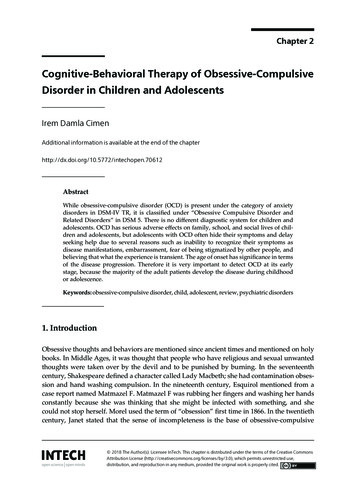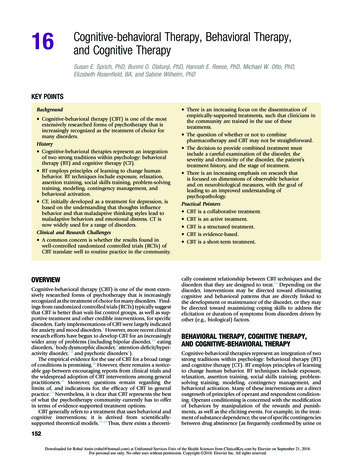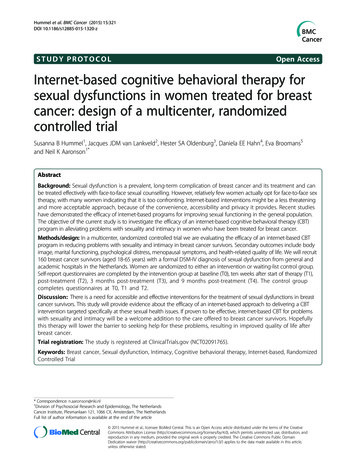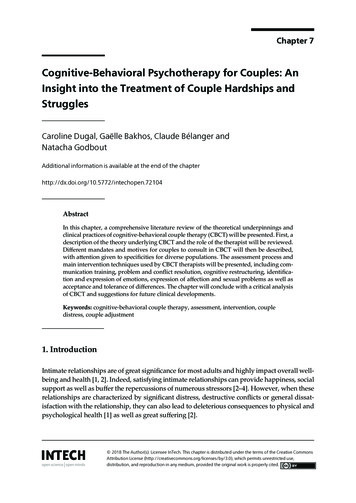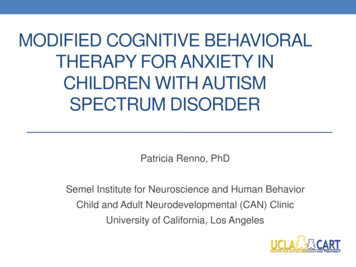
Transcription
FACT SHEET“CBT helps individualsbecome aware of theirthoughts and behaviors, witha focus on exploring howthese impact their emotions.”Cognitive BehavioralTherapy for Psychosis (CBTp)AUTHOR: KATE HARDY, CLIN.PSYCH.DStanford University Department of Psychiatry and Behavioral HealthWhat is Cognitive Behavioral Therapy?Cognitive Behavioral Therapy (CBT) is an evidence-based talking therapy that concentrates on how anindividual’s thoughts, behaviors, and emotions are connected. CBT helps individuals become aware of theirthoughts and behaviors, with a focus on exploring how these impact their emotions. The “here and now” focusallows for the development of skills to identify and address unhelpful thinking patterns and behaviors. As part of CBT,formulation (or case conceptualization) allows for the exploration of past experiences to gain an understanding of: how predisposing factors may have underpinned the current links between experiences, thoughts, emotions, andbehaviors; andhow that increases the individual’s vulnerability to developing mental health problems.Technical Assistance Material Developed for SAMHSA/CMHS under Contract Reference: HHSS283201200002I/Task Order No. HHSS28342002TCognitive Behavioral Therapy for Psychosis (CBTp)
CBT is recommended as a first-line intervention for the treatment of mild to moderatedepression and anxiety (NICE, 2014) and as an adjunct to medication management inthe treatment of more serious mental health problems. CBT is a structured therapy withsessions that follow a similar course and outline regardless of the presenting problem.This outline includes: a review of the week; development of an agenda for the session;review of homework; cognitive and/or behavioral skill acquisition related to an identifiedproblem area; and, finally, setting homework so that the client can practice these newskills in their own environment. The therapist may summarize the session or ask theclient to do so and will request feedback so that subsequent sessions can be tailored tofit with what the client found most helpful. Adaptations to this format may be requireddepending on the client population. Table 1 shows a list of the key features of CBT(Beck, 1995).TABLE 1: Key features of CBT Collaborative with active participation Builds on a strong therapeutic alliance Structured Time limited Goal and recovery oriented Formulation driven Draws upon a variety of cognitive and behavioral techniques Generalization of skills through homeworkWhat is Cognitive Behavioral Therapy for psychosis?Psychosocial interventions were long overlooked as a treatment for psychosis.Cognitive Behavioral Therapy for psychosis (CBTp) was initially developed as anindividual treatment, and later as a group-based intervention, to reduce the distressassociated with the symptoms of psychosis and improve functioning. Studies havedemonstrated that CBTp can result in decreased positive symptoms, improvement innegative symptoms, and improved functioning (Wykes et al., 2008; Burns et al., 2014;Turner et al., 2014, van der Gaag, Valmaggia & Smit, 2014). In addition, there isevidence to suggest that CBTp can be effective in preventing, or delaying, the transitionto full psychosis when used with individuals identified as being at risk of developingpsychosis (Stafford et al., 2013). From these studies, CBTp has emerged as anevidence-based intervention recommended as an adjunct to medication management(Dixon et al., 2010; NICE 2013; NICE 2014).Different treatment protocols exist, and recently the field has moved toward delineatingdifferent levels of CBTp treatment. These include: Cognitive Behavioral Therapy for Psychosis (CBTp)Full CBTp, defined as the intention to provide 16 or more one-to-one sessionsover at least six months by a CBT therapist (a therapist with CBT background/2
qualification and additional CBTp training)—for example, formulation-driven CBTp(Morrison, 2017);CBT-informed interventions, defined as interventions provided by mental healthpractitioners not meeting the criteria of a full CBTp therapist, such as CopingStrategy Enhancement (Tarrier et al., 1993) and nurse-delivered CBT-informedinterventions (Turkington, Kingdon, & Turner, 2002);Targeted CBTp interventions, targeting clearly specified mechanisms with a CBTptherapist, such as Worry Intervention (Freeman et al., 2015), AVATAR therapy (Leffet al., 2014), Cognitive Therapy for Command Hallucinations (Birchwood et al.,2014), and Individual Resiliency Training (Penn et al., 2014).CBTp is grounded in the guiding principles of CBT. However, Brabban et al. (2016)propose that three features have emerged as essential:1. The collaborative development of a shared formulation to inform the understanding,2.3.and maintenance, of psychotic symptoms and to aid in making sense of theseexperiencesNormalization of the psychotic experience to address the stigma that often isassociated with psychosisAcceptance of psychotic symptoms, which highlights the primary goal of thisapproach to reduce distress relating to the symptoms, rather than attempting toalter the occurrence of the symptoms.CBTp typically progresses through the following phases:1.2.3.Engagement and befriendingBrabban et al. (2016) emphasize the importance of the therapeutic relationship inCBTp, arguing that this feature is an essential aspect of the approach while alsoa preference prioritized by consumers. This phase may occur over an extendedperiod if a consumer is reluctant to engage in therapy, has had previous negativeexperiences with mental health providers, or is experiencing symptoms that impacttheir ability to engage in a therapeutic relationship, such as paranoia. During thisphase, the client will be supported to identify the key issues with which they arecurrently struggling in the form of a “problem list” and to develop correspondinggoals to aid in their recovery.Assessment of experiencesCBTp requires the clinician to support clients in exploring their symptoms while also“sitting on the collaborative fence.” This is defined as a collaborative explorationof these experiences, with the therapist dropping the expert role and assumptionsthat they might hold about these symptoms, as well as being open to multiplepossible explanations. By doing this, the therapist is modeling flexibility in thinking,openness to alternate explanations, and collaboration.Formulation developmentThe formulation aims to help the client, and his/her therapist, gain a betterunderstanding of the links between the client’s early experiences, core schema,Cognitive Behavioral Therapy for Psychosis (CBTp)3
unhelpful thinking patterns, and maintenance of current symptoms. Importantly, theformulation informs intervention since it highlights changes that may need to takeplace to address distressing symptoms. Figure 1 shows a maintenance formulationas an example. This type of formulation helps the client understand the linkbetween their interpretation of the event and subsequent behavioral and affectiveresponses, and in particular highlights the role that the interpretation and behaviorhave in maintaining the emotion.EVENTINTERPRETATIONEMOTIONSBEHAVIORFigure 14. Application of intervention and skill buildingDrawing upon the formulation, and in collaboration with the client, interventions aredeveloped that address issues identified by clients in their “problem list” in orderto support them in achieving the goals established at the beginning of therapy. Arange of cognitive and behavioral interventions exist that have been developed totarget specific psychotic symptoms. These include, but are not limited to, copingskills for managing voices, exploring the evidence for unusual and distressingbeliefs, and increasing functioning by addressing negative symptoms.5. Consolidation of skillsSince CBTp is a collaborative therapy, it requires the active participation of theclient within the session as well as between sessions. This allows the client toactively test the skills discussed in session in the real world and to provide feedbackto the therapist on the efficacy of the intervention, allowing for adaptation wherenecessary. Ultimately, the aim is to support the client to become their own CBTptherapist by teaching them the skills outlined above.CBTp and early intervention in psychosisCBTp is recommended for those experiencing a recent onset of psychosis and thoseat risk of developing psychosis (NICE, 2014). As such, CBTp has been widely adoptedas an individual therapy approach within early psychosis service settings. As shown inTable 2, the principles of CBTp are well aligned with the principles of early intervention inpsychosis as laid out in the Early Psychosis Declaration (Bertolote and McGorry, 2005).Cognitive Behavioral Therapy for Psychosis (CBTp)4
TABLE 2: Early intervention principles and CBTpEarly intervention principles(based on Bertolote and McGorry, 2005)CBTpProvide interventions with demonstrated efficacyEvidence basedProvide services that actively partner with youngpeople (shared decision-making) Client-generated problem list and goals Collaborative approach (the “collaborativefence”) Development of shared understandingthrough formulationChallenge stigmatizing and discriminatory attitudesNormalizationGenerate optimism and expectation or positiveoutcomes and recovery Problem list and goals Focus on functional recovery (not symptomreduction) Development of skills and tools to supportand maintain recovery Wellness planningCulturally sensitive servicesIndividualized formulationRespect the right for family and friends to participatein treatmentInclude family and important support peoplein sessions and wellness planning as desiredby the consumerIndividualized Resiliency Training (IRT; Penn et al., 2014) is another well-establishedindividual therapy model specifically designed for individuals experiencing a recentonset of psychosis. IRT has been implemented widely in the United States as partof the RAISE NAVIGATE model (Heinssen, Goldstein, & Azrin, 2014). IRT similarlydraws on a CBT background and consists of 14 modules (seven standardized andseven individualized modules) covering a range of topics, including education aboutpsychosis, processing the psychotic episode, relapse prevention planning, developingresiliency, managing distress, coping with symptoms, improving social functioning, andaddressing substance abuse. This manualized approach includes handouts for each ofthe module topics that summarize pertinent information and also provides worksheets.It is provided over the course of 6 to 24 months (sometimes longer), depending on clientgoals, needs, and preferences. IRT and CBTp share many common features. WhileCBTp emphasizes the role of individualized formulation to inform intervention selection(that may draw upon a wide range of treatment approaches), IRT draws on a broadrange of psychosocial treatment methods, psychoeducation, motivational enhancement,cognitive restructuring, coping skills enhancement, and social skills training. Thesemodels can be seen as complementary in nature, and clinicians working with earlypsychosis may benefit from familiarity with and training in both approaches sinceindividual consumers may have a preference for one over the other.Cognitive Behavioral Therapy for Psychosis (CBTp)5
Intervening early with CBTp: A case exampleBelow is an example of a typical client presenting with concerns relating to auditoryhallucinations. To demonstrate the skills discussed, the presentation is oversimplified,with a focus on treating the distress related to hallucinations. However, it is commonthat people presenting for CBTp will be experiencing multiple problems, and an initialgoal of therapy may be to support the individual to specify the problems and identifywhat they want to focus on first.Cesar is a 19-year-old Hispanic male who was recently accepted into the earlypsychosis service following the onset of distressing auditory hallucinations and paranoia(for a case example of CBT for clinical high risk of psychosis, see Hardy & Loewy,2012). Cesar has reluctantly agreed to meet with a case manager who is trained inCBTp. The following outline provides an example of his treatment using this approach.1. Engagement and befriendingCesar’s pathway into care included an involuntary hospitalization following anincrease in paranoia. Cesar had been found by the police wandering around aparking lot, mumbling to himself, and acting erratically. When approached by thepolice, he had attempted to run away but was quickly apprehended. The police,recognizing that Cesar was experiencing auditory hallucinations, took him to theER, where he was admitted involuntarily. Following this experience, Cesar is waryof services and mental health professionals but has reluctantly agreed to attendsessions at the early psychosis service program at the request of his parents.The case manager, Tony, initially focuses on engaging Cesar and exploring hisstrengths and interests, and learns that he has a passion for fishing. As such,Tony and Cesar arrange to meet in the local park and plan to conduct their initialsessions there, with Cesar taking the lead in teaching Tony how to fish. During thisprocess, the case manager is able to support Cesar to create a problem list andcorresponding goals (Table 3). The problem list identifies three problems, but forthe sake of simplicity this case example will focus on the first one.TABLE 3: Problem list and corresponding goalsPROBLEMGOALHearing “things”Reduce how stressed Cesar feels (from 90% to 50%) whenhe hears things by learning skills to manage stress in the nextfour sessionsArguing with familyLearn three new skills to improve communication with momand dad in the next monthGetting lower grades in schoolIncrease grades in school from Ds to Cs over the nextsemester by developing new skills to manage homework load2. Assessment of experiencesTony and Cesar continue to fish weekly, and during the process Tony takesthe opportunity to try to learn more about Cesar’s experiences using curiousCognitive Behavioral Therapy for Psychosis (CBTp)6
questioning to explore the onset and development of the voices. This helpsnormalize Cesar’s experience and reduce his self-stigmatizing view of what auditoryhallucinations represent and how Cesar makes sense of this o, when did you first hear a voice?I dunno, like six months ago maybe.Huh, so what was that like the first time?It was weird, man. I dunno, I kind of just ignored it at first. Then it gotlouder, and started saying mean stuff. Then it was harder to ignore.What do know about hearing voices?Just that it means you’re crazy.Really? Hmm, did you know that it is actually a pretty common experience?No.Yeah, people have all kinds of different experiences, but it is really commonto hear things that other people can’t hear, especially at times of stress. I’veheard a voice before.You?Yeah, not long after my abuela died. I was in bed about to fall asleep, and Iheard her call my name. It was actually kind of nice to hear her, even though Iknew she wasn’t really there. Are you OK with us talking about this stuff?Yeah, I guess.So why do you think you hear the voice? Any theories?It’s confusing. I used to be pretty sure that it was kids at college messingwith me. I thought they had somehow got access to my phone and weretransmitting messages through it to me, saying mean stuff, that kind of thing.But then I went to a hospital and they started me on medication and now I amnot sure. I mean, I still kind of think that’s what’s going on, but the doctors andmy parents tell me that the voices aren’t real, even though they sound very realto me. What do you think? Are the kids messing with me, or am I crazy?Wow—neither of those sound like great options. Y’ know, I wonder if thatis a question that we could keep thinking about together. Seems like youhave been doing a lot of thinking about this, and I reckon if we put our headstogether we might be able to come up with an explanation that makes sense,and it might not be either of the two that you mentioned. What do you think?Yeah, we could do that.3. Formulation developmentThe information gathered in these initial sessions is used to develop a formulationcollaboratively. Initially this consists of a maintenance formulation that illustrateshow Cesar interprets the threatening voice that he hears and how this interpretationimpacts how he feels and acts. Figure 2 demonstrates this idiosyncratic formulation.This simple maintenance formulation is a typical starting point for CBTp, as it helps toidentify interventions to address thoughts and behaviors. Later sessions may buildon this formulation, and further assessment of symptoms and past experiences canyield information that helps inform a longitudinal formulation. This type of formulationdraws on an individual’s early experiences to help understand how certain coreCognitive Behavioral Therapy for Psychosis (CBTp)7
Hears a threatening voice“Kids at school aresending messages to me.”Stays in room, ruminates,covers phone in tin foilScared, anxiousFigure 2beliefs, or rules for living, may have formed and how, in turn, these core beliefsinform the interpretation of an event. This can help clinicians, or a clinical team,gain a better understanding of how a client responds to certain situations and helpthe client recognize and more effectively respond to patterns in their thinking andbehavior. Although formulation is done in collaboration with the client, complex caseformulation can be used as a core feature of clinical team meetings to support teamtreatment planning (Berry et al., 2015). Figure 3 (based on Morrison, 2001) illustratesan example of this for Cesar, demonstrating how his experience of his father beingdeported to Mexico when he was just 7 years old and his own bullying from the agesof 8 to 12 had an impact on his world and self-view. With the core beliefs of “I am notsafe” and “Others can’t be trusted,” it is understandable that he interprets the auditoryhallucination as negative and threatening.Hears a threatening voice“Kids at school are sending messages to me.”I am not safe; others can’t be trusted.Stays in room,ruminates, coversphone in tin foilFather deported to Mexico; physicallybullied by school friendsScared,anxiousFigure 34. Application of intervention and skill buildingThe maintenance formulation is used initially to identify where interventionmay be the most helpful. To support the collaborative nature of CBTp, Tonyasks Cesar to review the formulation and identify where he thinks it mightbe important for them to focus. As with any CBT intervention, it is possibleCognitive Behavioral Therapy for Psychosis (CBTp)8
to intervene at either the cognitive or behavioral level (or both). Choosing theintervention level will be dependent on client choice and the goals of therapy. Giventhat Cesar wants to learn skills to manage how stressed he feels when hears thevoices, they agree to focus on his behaviors, in particular addressing how much heruminates about the experience. Tony introduces Cesar to a list of coping skills formanaging voices, and they review this together and identify three skills that he willbe willing to try out at home. In later sessions, they begin to explore the thought“The kids at school are sending me messages” (Table 4). Together, Tony and Cesarexplore evidence for and against this thought, with Tony asking Cesar to rate howmuch he believes this thought before and after they have examined the evidence.During this process, Cesar is relieved to find that there is limited evidence tosuggest that the students at school are sending him messages and that it is morelikely that he is experiencing an auditory hallucination. However, given that Cesarhas already shared that he believes that people who hear voices are “crazy,” isit important that Tony now works with Cesar to examine this new interpretationof his experience. Together, they are able to come up with a realistic and morehelpful interpretation of the experience, with Cesar identifying that he experienceshallucinations when he is stressed and tired, ultimately seeing these experiences asan understandable response to being overwhelmed.TABLE 4: Exploring the evidenceTHOUGHT: The kids at school are sending me messages. (90% sure this is true)EVIDENCE FOREVIDENCE AGAINST I hear mean things. They don’t like me. I heard one of the people This happens when my phone is off and covered up. When I checked, no one else can hear it. A few people at school do like me, and they don’t think this isat school talking aboutusing phones to spy onpeople.happening. It’s unlikely that school kids could access technology thatcould send messages through a phone that wasn’t turned on.THOUGHT: The kids at school are sending me messages. (40% sure this is true)ALTERNATIVE THOUGHT: It’s an auditory hallucination. (60% sure this is true)5. Consolidation of skillsThe interventions described above are all supported by Cesar practicing the skillsdiscussed in session at home. Cesar tries out the coping skills at home and reportsto Tony how successful they were in reducing his stress, thereby allowing them tofine-tune these skills over subsequent sessions. Exploration of the thought “Thekids are sending me messages” required Cesar to do some investigating at homeand at school, including asking trusted family and friends about this experienceand reporting back to Tony what he learned through this process. The final stageof therapy for Cesar is a review of the skills he has learned and the development ofa wellness plan that allows Cesar to think about what he will do if his stress levelsincrease in the future (Table 5). This wellness plan is shared with his parents andthe rest of the early intervention team.Cognitive Behavioral Therapy for Psychosis (CBTp)9
TABLE 5: Wellness planIf my stress level increases to the following, I will:LevelPlan50%Use my coping skills75%Talk to my mom and aunty, take medication as needed, call Tony100%Consider going to the ERWhat are the training requirements for CBTp?Clinicians who want to practice CBTp should receive training in this approach from aprofessional with expertise in this area. Training is typically conducted over multipledays and requires the clinician to have a good working knowledge of the basicprinciples of CBT. However, didactic training in this approach is just the beginning.Studies have shown that 50 percent of implementation efforts result in failure (Klein andKnight, 2005); as such, sustainable practice change needs to be supported throughregular consultation following the training (Stirman et al., 2010). This consultationprocess allows clinicians to discuss the real-world application of the skills they havelearned; troubleshoot problems as they arise; and celebrate successes while allowingthe training to ensure that the skills are applied in a manner consistent with the model.To fully establish that the clinician has been able to integrate CBTp into their clinicalpractice, clinicians are typically required to submit taped sessions for competencereview. The revised cognitive therapy scale (CTS-R; Blackburn et al., 2001) iscommonly used to determine the competence of the clinician on a range of domains ofCBT practice. A clinician is typically deemed to be competent in this approach whenthey have submitted three consecutive tapes that are scored at 50 percent or aboveusing the CTS-R. Other competence measures exist and may be used to establishclinical competence; however, the same requirement of submitting a fixed number ofsessions that exceed an established competence cut-off is commonly applied. Onceclinical competence is established, clinicians benefit from ongoing case consultation(Brabban et al., 2016) to discuss complex cases with a team, troubleshoot difficulties,and remain current with innovations in this approach.Although the training model outlined above is directed at clinicians learning full CBTp,there are benefits to all team members being involved in this process. In particular, itcan be helpful for team members to have a good understanding of the interventionsoffered by the service, regardless of their role on the team. In addition, CBTpinterventions often draw upon support people, such as family members or non-therapystaff, to test new hypotheses, execute behavioral experiments, and practice copingskills. As such, a coping skill developed in session with the clinician may be put intopractice in the school environment, with the supported education and employmentworker assisting.Cognitive Behavioral Therapy for Psychosis (CBTp)10
WHERE CAN I LEARN DGMENTSThanks to Dr. Kim Mueser and Dr. Sally Riggs for reviewing and providing feedback onearlier versions of this fact sheet.REFERENCESBeck, J. S. (1995). Cognitive therapy: Basics and beyond. New York: Guilford Press.Berry, K., Haddock, G., Kellett, S., Roberts, C., Drake, R., & Barrowclough, C. (2015). Feasibility of award-based psychological intervention to improve staff and patient relationships in psychiatricrehabilitation settings. British Journal of Clinical Psychology, 55(3), 236–252. https://doi.org/10.1111/bjc.12082Bertolote, J., & McGorry, P. (2005). Early intervention and recovery for young people with early psychosis:Consensus statement. British Journal of Psychiatry, 187(48), s116–s119. https://doi.org/10.1192/bjp.187.48.s116Birchwood, M., Michail, M., Meaden, A., Tarrier, N., Lewis, S., Wykes, T., Davies, L., Dunn, G., & Peters, E.(2014). Cognitive behaviour therapy to prevent harmful compliance with command hallucinations(COMMAND): A randomised controlled trial. The Lancet Psychiatry, 1(1), 23–33. burn, I., James, I., Milne, D., Baker, C., Standart, S., Garland, A., & Reichelt, F. (2001). The revisedcognitive therapy scale (CTS-R): Psychometric properties. Behavioural and Cognitive Psychotherapy,29, 431–446.Brabban, A., Byrne, R., Longden, E., & Morrison, A. P. (2016). The importance of human relationships,ethics and recovery-orientated values in the delivery of CBT for people with psychosis. 59648Burns, A. M. N., Erickson, D. H., & Brenner, C. A. (2014). Cognitive-behavioral therapy for medicationresistant psychosis: A meta-analytic review. Psychiatric Services 65(7), 874–880. https://doi.org/10.1176/appi.ps.201300213Dixon, L. B., Dickerson, F., Bellack, A. S., Bennett, M., Dickinson, D., Goldberg, R. W., Lehman, A., Tenhula,W. N., Calmes, C., Pasillas, R. M., Peer, J., & Kreyenbuhl, J. (2009). The 2009 Schizophrenia PORTpsychosocial treatment recommendations and summary statements. Schizophrenia Bulletin, 36(1),48–70. https://doi.org/10.1093/schbul/sbp115Freeman, D., Dunn, G., Startup, H., Pugh, K., Cordwell, J., Mander, H., Černis, E., Wingham, G., Shirvell, K.,& Kingdon, D. (2015). Effects of cognitive behaviour therapy for worry on persecutory delusions inpatients with psychosis (WIT): A parallel, single-blind, randomised controlled trial with a mediationanalysis. The Lancet Psychiatry, 2(4), 305–313. , K. V., & Loewy, R. (2012). Cognitive behavioral therapy for adolescents at clinical high risk forpsychosis. Adolescent Psychiatry, 2, 172–181. n, R. K., Goldstein, A. B., & Azrin, S. T. (2014). Evidence-based treatments for first episodepsychosis: Components of coordinated specialty care (White paper). Bethesda, MD: NationalInstitute of Mental Health. ia/raise/nimh-white paper-csc-for-fep 147096.pdfCognitive Behavioral Therapy for Psychosis (CBTp)11
Klein, K. J., & Knight, A. P. (2005). Innovation implementation: Over-coming the challenge. CurrentDirections in Psychological Science, 14(5), 243–246.Leff, J., Williams, G., Huckvale, M., Arbuthnot, M., & Leff, A. P. (2014). Avatar therapy for persecutoryauditory hallucinations: What is it and how does it work? Psychosis, 6(2), 166–176. on, A. P. (2001). Interpretation of intrusions in psychosis: An integrative cognitive approach tohallucinations and delusions. Behavioural and Cognitive Psychotherapy, 29(3), 257–276. https://doi.org/10.1017/S1352465801003010Morrison, A. P. (2017). A manualised treatment protocol to guide delivery of evidence-based cognitivetherapy for people with distressing psychosis: Learning from clinical trials. Psychosis. nal Institute for Health and Care Excellence (NICE). (2013). Psychosis and schizophrenia in childrenand young people (Clinical guideline 155). NICE. https://www.nice.org.uk/guidance/cg155National Institute for Health and Care Excellence (NICE). (2014). Psychosis and schizophrenia in adults:Prevention and management (Clinical guideline 178). NICE. https://www.nice.org.uk/guidance/cg178Penn, D. L., Meyer, P. S., Gottlieb, J. D., Cather, C., Gingerich, S., Mueser, K. T., & Saade, S. (2014).Individual Resiliency Training (IRT). Bethesda, MD: National Institute of Mental Health. Complete%20Manual.pdfStafford, M. R., Jackson, H., Mayo-Wilson, E., Morrison, A. P., & Kendall, T. (2013). Early interventions toprevent psychosis: Systematic review and meta-analysis. BMJ (Clinical Research Ed.), 346, f185.https://doi.org/10.1136/bmj.f185Stirman, S. W., Bhar, S. S., Spokas, M., Brown, G. K., Creed, T. a., Perivoliotis, D., Farabaugh, D. T., Grant,P. M., & Beck, A. T. (2010). Training and consultation in evidence-based psychosocial treatments inpublic mental health settings: The access model. Professional Psychology: Research and Practice,41(1), 48–56. https://d
Cognitive Behavioral Therapy (CBT) is an evidence-based talking therapy that concentrates on how an individual’s thoughts, behaviors, and emotions are connected. CBT helps individuals become aware of their thoughts and behaviors, with a focus on exploring

